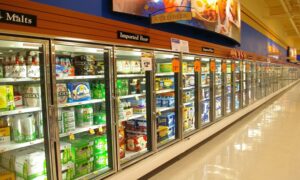The future trends in TES for cold storages are primarily towards an efficient way of transferring the cold from TES to the cold storage units.
Cold thermal energy storage (CTES) systems can be classified according to the type of thermal storage medium. Cool storage media include chilled water, aqueous or non-aqueous fluids, ice, and phase change materials. Energy can be stored in two forms – either sensible or latent.
Thermal energy can be stored in the latent heat of fusion of water (ice) or other materials. Water has the highest latent heat of fusion of all common materials (334kJ/kg), high density, safety, appropriate fusion temperature and insignificant cost. Although sensible cold thermal storages are simple and cost-effective, the size of these devices is quite large when compared to ice storage.
Further classification of this system can be done based on the mechanisms utilized to extract cooling from CTES and thereby transferring to the cold storage. It is currently being done through cooling directly via air or liquid loops, which have lower cooling rates and higher pinch point temperature across the TES and cold storage (at the best 7C). The primary drawback is the utilization of sensible capacity of heat transfer medium. An advanced approach is to utilize latent capacity of heat transfer medium such as 2 phase cooling mechanisms.
Ensuring safety of perishable food products
Latent energy based CTES systems can reduce the risk of spoilage of perishable commodities in following ways:
- CTES can dump large amount of energy in a short period which helps in effective precooling. The lesser time it takes to bring the core temperature of perishable commodity from ambient to storage temperature, better is the quality/preserved freshness of it. Large scale deployment of such systems at the source of production will result in better quality and higher shelf life of the perishables.
- Traditional cold coupled with CTES can prevent the spoilage of perishable commoditiesby providing cooling during extended power cuts.
- Solar powered CTES based off-grid cold storage systems can even be used in remote areas to prevent spoilage of perishable commodities.
Field of application
CTES based cooling systems have following applications:
- Using grid powered CTES instead of Diesel based cooling systems. For example, refrigerated trucks, tourism boats, ships, etc. If CTES based cooling systems (where ice formation was done on grid) are used instead of diesel-powered alternators on these systems, operational cost decreases and the carbon reductions help in reducing environmental pollution.
- Remote areas in developing countries with no or less availability of grid power can utilize solar power to be stored within CTES to provide 24 X 7 cooling.
- In developed countries, CTES systems can help in shifting of peak load to an off-peak period.
Future Trends
Elucidating on the future trends that can give a face lift to India’s cold, Nitin Goel, CEO, Inficold India Pvt. Ltd., says “It is traditionally accomplished through air or water cooling. However, the parameters associated towards effective heat transfer such as heat transfer area, heat transfer coefficient and sensible heat capacity of air/water cooling is limited resulting in very low cooling rates. Such a challenge is currently circumvented through the utilisation of lower temperature phase change material instead of water.” However, there is an additional penalty of lower efficiency from electrical energy to storage and later from storage to cooling. A future trend is to utilise two phase cooling medium such as refrigerant, which enables 10x increased heat transfer coefficients and lower parasitic electrical power for pumping the heat transfer fluid. There are few companies across world such as Inficold, which are working on such next generation technologies.
Cookie Consent
We use cookies to personalize your experience. By continuing to visit this website you agree to our Terms & Conditions, Privacy Policy and Cookie Policy.















